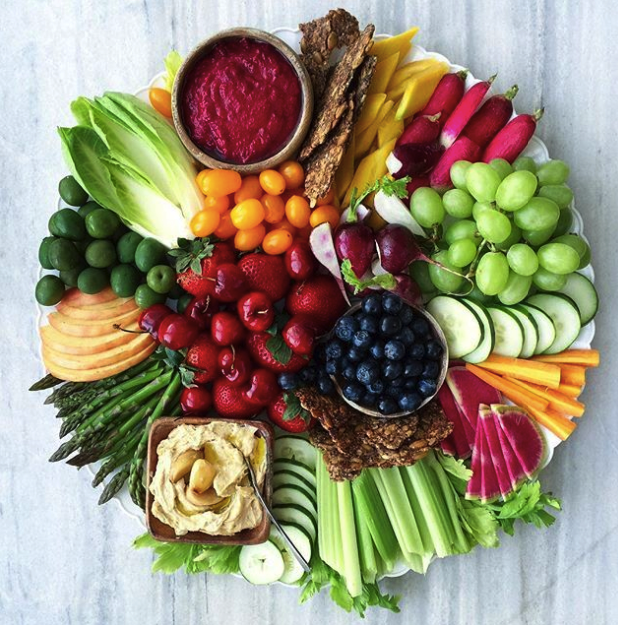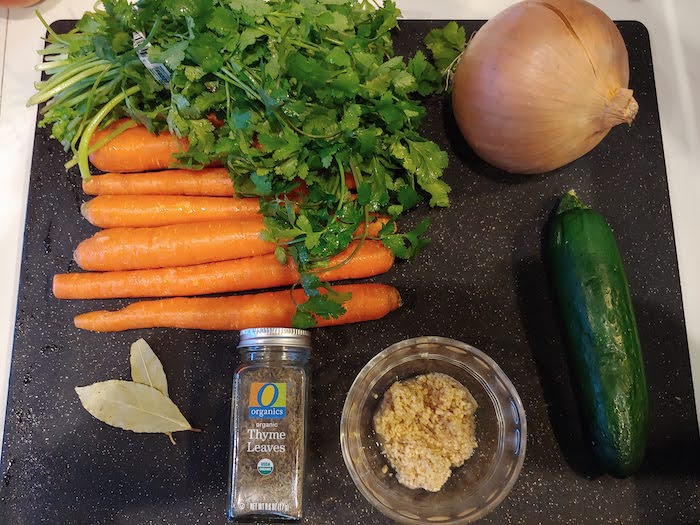
What is a Plant Based Diet? The Fundamentals and How to Know if it’s Achievable For You
Have you thought about trying a plant-based diet?

If you answered “yes”, you’re in good company. Plant-based diets are on the rise – around 10 million Americans say they follow a “plant-based” diet. That’s up from 290k in 2004! Interestingly, the number of self-identifying “vegans” hasn’t changed much.
Are you asking yourself, “what’s the difference between vegan and plant-based?”
In this post, we’ll get clear on just what a plant-based diet is (and is not). At the end, you’ll have the information you need to decide if you want to try plant-based yourself.
What You Need to Know About Plant-Based Diets
Let’s first define a plant-based diet and distinguish it from other “veg-X” diets. Then, we’ll talk about some pros and cons of plant-based diets, and see what a balanced plant-based diet might look like.
By the end, you’ll know exactly what a plant-based diet is, if you are already eating one, and if you want to try it.
Plant-Based Diet DEFINED
In the broadest sense, plant-based diets focus on foods primarily from plants. This includes not only fruits and vegetables, but also nuts, seeds, oils, whole grains, legumes, and beans.
In contrast to a vegan diet, eating a plant-based diet doesn’t mean that you eat “plants-only”, are vegetarian or vegan, or never eat meat or dairy. Instead, plant-based is a general term, meaning that you choose most of your foods from plant sources. A well-known example of a plant-based diet is the Mediterranean Diet.
Remember, all vegetarian diets are plant-based, but not all plant-based diets exclude animal-based foods.
To clear things up a bit, here’s a table that compares different plant-based diets based on what they do/don’t eat or buy:

While plant-based diets are characterized by a high intake of plant foods, the exact composition of healthy, balanced plant-based diets can differ. On the whole, plant-based diets include:
- high consumption of vegetables, fruit and whole grains,
- some low-fat dairy products (or dairy alternatives), seafood, nuts, seeds, legumes, and oils
- lower intakes of fatty/processed meats, refined grains, sugar-sweetened foods and beverages
- lower salt and lower saturated fat content than typical American or Western-style diets
As you can see, there are no strict criteria for eating a plant-based diet, and there is a lot of room for flexibility and interpretation!
PROS and CONS of Plant-Based Diets
PROS: In general, plant-based diets are healthy and beneficial. Overall, plant-based diets are associated with lower risk of major chronic diseases such as heart disease, diabetes, cancer, and others.
Note that plant-based eaters tend to be a more health-conscious in general, so it’s hard to know whether they are healthier because of their plant-rich diet or for one of these other reasons:
- Plant-based eaters tend to have healthier habits – they get more regular exercise, go to their doctor regularly, get more sleep, are better flossers (it’s true!). This makes sense – someone who cares enough about their diet to go plant-based probably cares about their health in general.
- Um, they eat more plants, which tend to be less-processed and contain more fiber, natural fat, and a long list of nutrients, antioxidants, and phytonutrients. Real-life example: Your plant-based friend who packs a salad for lunch vs the other friend who picks up a deli sandwich and bag of chips.
- Less-processed and whole plant foods are filling! They have a lot of water and fiber, so your stomach gets full and digestion slows down. The result: a plant-based eater consumes fewer calories overall, compared to a “regular” eater.
Who is plant-based eating for? People who have an open mind, embrace whole-food eating, enjoy searching for and preparing recipes, have support from family/friends, have a deep motivation for changing their diet, and are willing to be flexible from time to time.
Example: 50-year-old man with kids at home who has high cholesterol, enjoys and has time to spend in the kitchen, and wants to have a smaller carbon footprint. This man will likely embrace a plant-based diet because he has three motivators: his personal health (lowering his cholesterol), modeling healthy habits for his children, and he’s environmentally conscious. In addition, he’s already used to and enjoys preparing food.

CONS: Are there any downsides to eating plant-based? Well, there can be if you’re not eating in a balanced way, and especially for serious athletes, pregnant women, and growing children. They can be summarized as follows:
- Any time you omit entire food groups (especially true for vegans and vegetarians), you are by default eliminating certain nutrients from your body. For example, vegans are often deficient in vitamin B12, calcium, iron, Omega-3 fatty acids, and sometimes protein. These nutrients are either exclusively or especially available in animal products. So, vegans and some vegetarians must supplement their diets in order to get enough of some nutrients.
- Relying on highly-processed plant-based foods. Let’s face it – making whole-food, plant based meals all the time is difficult and time-consuming. It’s easy to start relying on plant-based convenience foods, of which there are a lot! Overall, however, highly-processed plant foods are just as unhealthy as their conventional counterparts.
- Overly restrictive eating. Plant-based eaters, especially those who are strictly opposed to certain foods, are at risk of disordered eating – from orthorexia (the obsession with “perfect” eating, which interferes with the enjoyment of food and life) to malnourishment. The irony is that overly restrictive eating often starts as a way to improve one’s health, but over time, develops into an unhealthy habit.
Who might struggle with plant-based eating? People who hate plant foods and/or love meat, are not ready to try less-processed foods, don’t have the time and energy to search out and prepare new foods, and don’t have a compelling reason to go plant-based.
Example: 60-year old woman who works full-time, is very active and in good physical health, loves and eats all food. This woman has little reason to change her diet to plant-based: she’s in good health, busy, and enjoys her current diet. So, she would likely struggle with starting – and maintaining – a plant-based diet.
Example Plant-Based Diet Daily Meal Plan
You may be curious about what a plant-based diet would look like? Here’s a one-day meal plan, based on a 2500-calorie/day diet:
| Meal | Foods | Calories | Carbs(g) | Protein (g) | Fat (g) |
| Breakfast | ½ cup rolled oats prepared with 1 cup vanilla soy milk 2 Tbsp peanut butter 1 banana | 574 | 75 | 22 | 24 |
| Snack 1 | Handful of almonds Large apple | 300 | 31 | 7 | 15 |
| Lunch | Lunch Bowl: 1 cup cooked brown rice ½ cup cooked green peas ½ cup cooked chickpeas 1 small roasted yam 2 cups spinach 1 Tbsp sunflower seeds 2 Tbsp raisins 2 Tbsp Balsamic vinaigrette | 618 | 90 | 20 | 21 |
| Snack 2 | ¼ cup hummus 10 baby carrots 10 broccoli florets Handful mixed nuts | 300 | 47 | 9 | 10 |
| Dinner | 3 oz filet of salmon 1 cup cooked quinoa with lemon and olive oil Salad: 1 cup mixed greens ½ large tomato 5 kalamata olives 1/2 mandarin orange 2 Tbsp Magic Sauce dressing 1 scoop coconut ice cream | 628 | 66 | 33 | 25 |
| Totals | 2420 | 309 | 91 | 95 |
As you can see, this meal plan is heavy on vegetables, fruits, whole grains, legumes, nuts and seeds; with a small amount of fish as the only animal food in the day. Keep in mind that there are many, many different ways to do a plant-based diet – this is just one example.
Nutritionally, this meal plan provides 51% of calories from carbohydrates, 15% from protein, and 35% from fat; which is a healthy composition for most adults. Notice that this meal plan has 91 g of protein, which may sound like a lot. However, a lot of plant-based eaters don’t get enough protein, and our bodies are a little less efficient at using plant protein. So, I wanted to show a doable whole-food, plant-based, protein-rich meal plan.
Even though this day’s worth of food is very nutritious; over time, I recommend plant-based eaters take a daily multivitamin (that includes iron and vitamin B12), as well as an Omega-3 EPA and DHA supplement. Read more about Omega-3 fatty acids here.
SUMMARY
Plant-based diets are made up of mostly plant foods, but they are not necessarily the same as vegan and vegetarian diets, because a plant-based diet can occasionally include small amounts of meat and animal products. There are many health benefits to plant-based diets, and they often require extra planning and food preparation.
To recap, here are the concepts we covered:
1. Plant-based diets are a way of eating where the diet is made up of mostly plant foods – fruits and vegetables, nuts, seeds, oils, whole grains, and legumes. Animal-based foods may or may not be included, but they are always a small part of the overall diet.
2. Plant-based diets can help people avoid chronic disease and they can have less impact on the environment. At the same time, a plant-based diet can be deficient in some essential nutrients.
3. We looked at a typical “day in the life” menu for a plant based diet, including nutrition information.
CONCLUSION
Plant-based diets are healthy, diverse, and offer the flexibility to eat animal products in small amounts. People who are already interested in their health, enjoy food preparation, or have ethical reasons for avoiding animal products find plant-based diets fit into their lifestyle. If you are interested in trying a plant-based diet, try it out for a few days and see what you think!
Did you find this information helpful? Leave questions or comments down below, share on social media, or email me at [email protected]!
Other Helpful Resources:
The Number of Americans Eating Plant-Based Diets Has Surpassed 9.7 Million
Plant-based nutrition: A complete guide for vegetarians, pescatarians, flexitarians, and more
Position of the Academy of Nutrition and Dietetics: Vegetarian Diets
Omega-3 Fatty Acids: An Essential Contribution
This is Meaty- 4 Reasons Humans Should Eat Animals
Plant-Based Recipes:
MAINS:
APPETIZERS & SNACKS:
SOUP:
30-Minute Creamy Broccoli Soup
SALADS & SIDES:
Salad SLAM – 4 Steps to Perfect Salads
SAUCES and DRESSINGS:
Creamy Peanut Sauce and Dressing
BREAKFAST:
Breakfast Bowl for Special Diets
SWEETS:
MISC
DIY Substitutions for Eggs and Milk
PIN THIS IMAGE:

POST KEYWORDS (Central Idea): Plant based diet, flexitarian, vegetarian, vegan, Mediterranean diet





